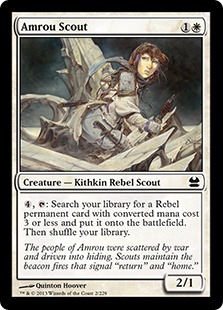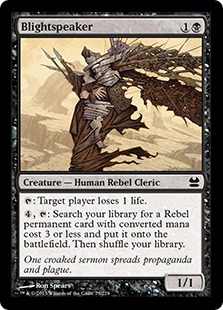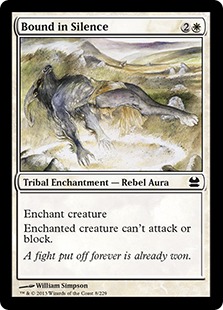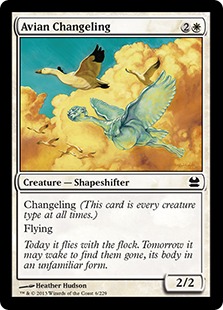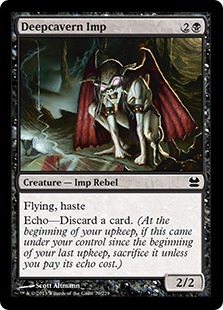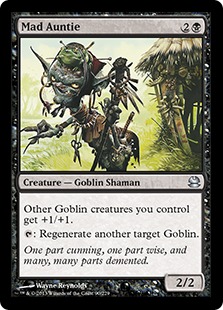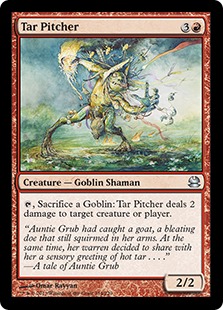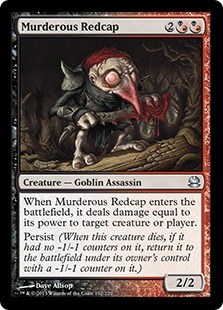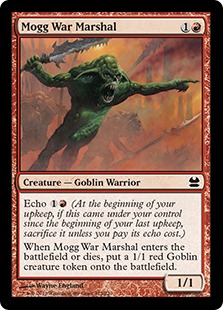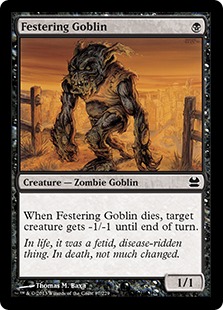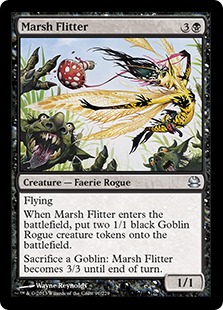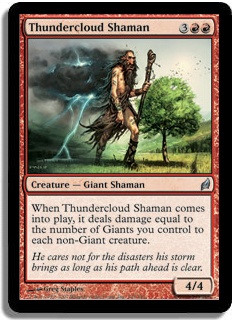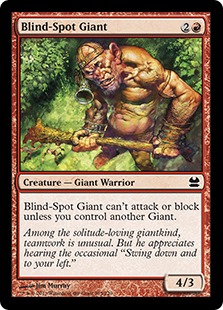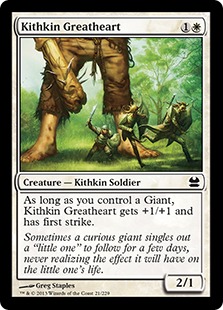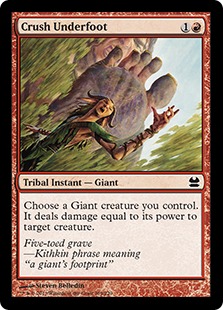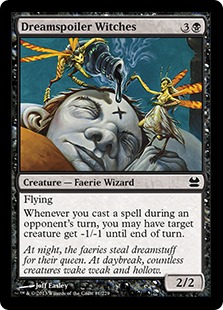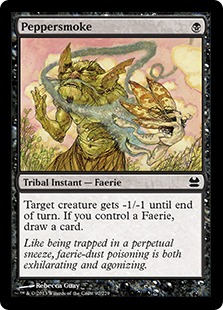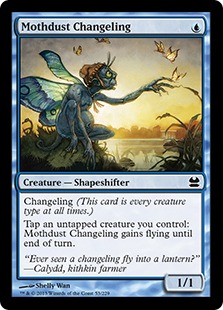Like many people out there, I saw Modern Masters as a profit-making opportunity. I could try to get my hands on some sealed product for MSRP, flip it, and make some extra cash to pay for my trip to Las Vegas for the Grand Prix. Everything was going according to plan when I was fortunate enough to get two sealed boxes from The Realm of Possibilities, a store in Santa Fe that is about 45 minutes away from my house.
Boxes in hand, I now had the choice of playing the Tarmogoyf lottery, selling the boxes on eBay, or drafting with it. The easy answer was to just sell it on eBay and make some quick cash, but friends suggested (can’t cite which friends said this, so we’ll just have to see who wants credit) we would do ourselves a greater service to draft it in preparation for the Grand Prix. I couldn’t argue with sound logic, so we ended up with an eight-man Rochester draft. Rochester drafting gave us all a much deeper understanding of what cards everyone valued and what archetypes were going to be prevalent in our draft.
For those who don’t know what Rochester Draft is, it is a Draft format where instead of everyone opening one booster pack at the same time and then picking a card, one booster at a time is opened face up and everyone makes a pick that is public. When you draft this way, there are no secrets, and you have access to information about every card in every person’s pool.
I ended up 2-1 in this draft, but now I had the fire to play even more Modern Masters. Last weekend we had two sealed Grand Prix Trials for Las Vegas that were Modern Masters Sealed. I did fairly well in both these tournaments (2nd and 5th) and want to share with you some insight that will hopefully help you make it to day 2 of Grand Prix Las Vegas.
It’s very important when opening your packs to first digest whether you have a strong tribe to build. Unlike Return to Ravnica Block Sealed, the tribes in Modern Masters are very defined and strong when built correctly. Before I break down the tribes, let me give you a couple of rules for Modern Masters Sealed:
1. Always play Bonesplitter.
It’s colorless and cheap to equip. It turns nearly any creature into a threat. It’s safe to say that playing every Bonesplitter you open is better than not.
2. Splash for Blinding Beam.
People forget that this card is not Frost Breath. Not only do you pick two creatures to tap down, but none of your opponent’s creatures get to untap the next turn. That’s all possible for a measly four mana!
3. Epochrasite goes well in almost any deck.
It’s colorless and makes your opponent hesitate to attack into it or block it in the early game. It also combos quite nicely with Flickerwisp and Otherworldly Journey.
I know that many of you have never played with these cards before, so after you’ve seen if you opened straight cash in your pack, let’s look at the different tribes to build from for our Sealed decks.
Rebels
When I first looked at the spoiler, I was unimpressed with the total number of Rebels:
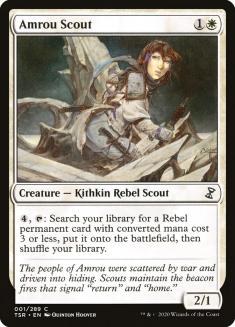
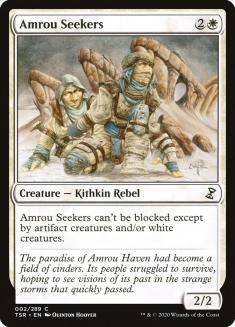
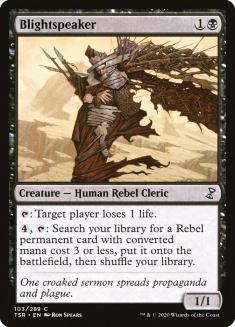
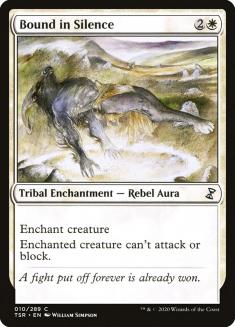
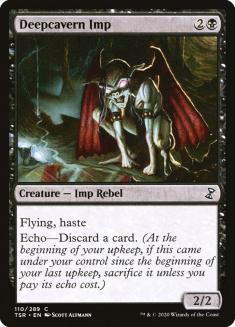
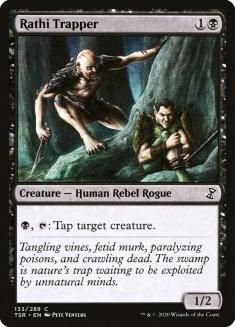
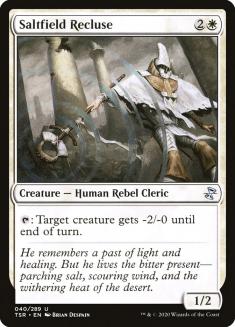
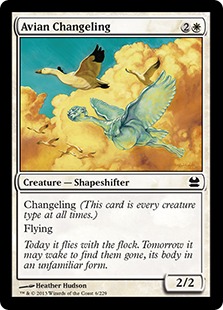
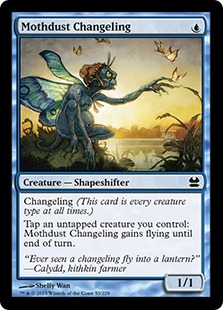
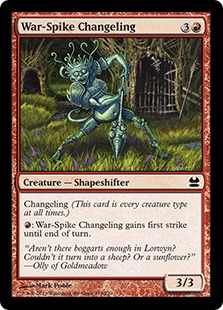
I saw only ten, and none of them are rare or game breaking. Well, after playing the format, I could not have been any more wrong when I said Rebels weren’t the real deal. Rebels are actually insane when you have multiples of the two tutors (Blightspeaker and Amrou Scout). I forgot that Modern Masters is a smaller set, which means that you will have a higher likelihood of opening multiples of the Rebels because they are all common.
When looking at your Sealed pool, here’s what you need if you want to play a good Rebel build:
1. 2+ Amrou Scout and/or Blightspeaker
These are the engine and the difference between a good Rebel deck and a bad one. When you have just one Rebel searcher, you are not likely to have it early to start filling your board with Rebels without using cards in your hand. Once you have two or three of these in your pool, you will consistently be able to build your board full of Rebels and abuse its built-in card advantage. I personally value Blightspeaker a fraction higher because in board stalls it’s good for a guaranteed one point of damage if you don’t search up a Rebel with it that turn.
2. At least one Bound in Silence
Turning off the ability for your opponent’s best creature to attack or block at instant speed is obviously very good. You also can enchant shroud creatures with Bound in Silence if you are searching it out of your deck! Putting it directly into play instead of casting it means you don’t target—you just choose. Take that, Scion of Oona!
3. At least one Amrou Seekers
Although it doesn’t say intimidate on it, that’s exactly what these guys have. Normally, you’ll be using them as the kill condition in your Rebel deck. Many of the nonwhite decks won’t have any way to block it, and if they do you’ll be using your Bound in Silence to make room for your Seekers to finish your opponent off.
4. At least one Rathi Trapper
Tapping down your opponent’s best creature and also having the ability to remove annoying blockers from combat is very important to your plan. In many games, you will Trapper their best creature while you continually search up more and more Rebels. At some critical mass of Rebels, you will need to tap down a creature during their end of turn and then tap down another creature before your combat to get through the final points of damage.
5. 2+ Avian Changeling and/or Deepcavern Imp
Flying is very important in Modern Masters. If your pool doesn’t have Amrou Seekers, you will want some Rebel that can pressure your opponent. Other times you will have used your Bound in Silence and will need blockers for flying monsters. Avian Changeling is much better than Deepcavern Imp because of the extra toughness, being a Changeling, and not having to discard as an echo cost. With that being said, you’ll almost certainly play all of these that you open in your Rebel deck. Just remember to search up the Changeling during your opponent’s turn and the Imp during your turn since it has haste. Getting it at the end of your opponent’s turn will make you have to pay the echo first and then attack and opens you up to a two for one without actually doing damage to your opponent.
6. 2+ Pump Spells
The issue I have with playing Rebel decks is that in Modern Masters our Rebels are very small. If we exclude War-Spike Changeling, no Rebel has over two power. Three of our Rebels are worse and have only one power. That can be pretty embarrassing if our opponent resolves even something as bad as Greater Mossdog. All of our Rebel decks should be playing every Bonesplitter that is opened so they can trade up the curve.
Our Rebels being small also makes us vulnerable to smaller damage removal spells like Peppersmoke, Electrolyze, Glacial Ray, Grapeshot, Murderous Redcap, Pyrite Spellbomb, Sudden Shock, and Tar Pitcher. All of the two damage spells will kill any Rebel in the deck, so we have to be able to fight that with pump spells like Otherworldly Journey, Runed Stalactite, and Test of Faith.
B/W Rebels is a very strong deck in Sealed. The reason it’s so good is because every time you search a Rebel out of your deck you are effectively drawing an extra card. As we all know, drawing extra cards is good. When you can choose what card you are drawing and cast it immediately, it’s very good.
Goblins
As a tribe, I find Goblins very exciting to play. Goblin decks are generally very aggressive and punish your opponents when they have slow draws. The issue I have with Goblin decks is that most of the time you’ll open a few Goblins but won’t have enough good Goblins to have a respectable deck in Sealed. The Goblins that make your deck good (Earwig Squad; Kiki-Jiki, Mirror Breaker; Mad Auntie; Murderous Redcap; and Tar Pitcher) are all rare or uncommon. Goblins is normally a good deck for Draft but not for Sealed.
When looking at your Sealed pool, here’s what you need if you want to play a good Goblin build:
1. At least one Mad Auntie
This card is really the only reason I would want to play Goblins in Sealed. Being able to give all of our Goblins +1/+1 and being able to protect them from dying is a combination I simply cannot overlook. If you play Mad Auntie in your deck, you will also play a Runed Stalactite so you can regenerate creatures that are not normally Goblins. I have not seen any good Goblin decks in Sealed that didn’t have one or two of these.
2. 2+ Tar Pitcher and/or Murderous Redcap
I prefer Tar Pitcher over Murderous Recap, but I believe that your deck needs two of these in any combination. Removal is hard to come by when attached to a creature, and in Goblin decks you have access to Warren Pilferers that can get them back later in the game. Tar Pitcher is very abusive when you can sacrifice tokens, Goblins that are about to die, or happen to have opened a Squee, Goblin Nabob. Both of these cards will certainly make any deck that is playing their colors, but for a dedicated Goblin deck they are crucial. If you play Tar Pitcher, again remember to play your Runed Stalactite.
3. 5+ Warren Pilferers, Mogg War Marshal, Festering Goblin, War-Spike Changeling
These guys are the meat and potatoes of your deck. Without multiples of these cards, you aren’t really playing a Goblin deck and should scrap playing your Mad Auntie. Although I said you are looking for some combination of five or more of these cards, four or more Pilferers is probably too many. I think the maximum is three, and I’d only play that many if I had some combination of four Mad Auntie / Tar Pitcher / Murderous Redcap / Warren Weirding.
4. At least one Marsh Flitter
While not technically a Goblin, it does make two Goblin tokens and has the ability to be a 3/3 flier. Play as many as you open in your Goblin deck.
Goblins can be very good in Sealed if you are lucky enough to open the right uncommons and rares, but on the whole I don’t feel that will happen enough to make it a good deck.
Giants
In Sealed, the desire to play Giants is directly proportional to how many Bonfire of Damned you open. Oh, you didn’t know Bonfire is in the set? Let me introduce you to the OG Bonfire aka Thundercloud Shaman.
Thundercloud Shaman literally reads 3RR, target opponent picks up this card, reads it, counts your Giants, looks at their board, and then shakes their head in misery as they put all their creatures in the graveyard. This card is lights out for most of your matches.
When looking at your Sealed pool, here’s what you need if you want to play a good Giant build:
1. At least one Thundercloud Shaman
As I said earlier, this card is the nuts. More than one is out of control, but simply having one in your deck is just fine too. I said before that Runed Stalactite tends to be good in all of these tribal decks, but with Thundercloud Shaman it will also keep alive your non-Giant creatures. Beyond its ability to wipe the board, it has a respectable 4/4 body that can put real pressure on your opponent.
2. At least one Blind-Spot Giant
A 4/3 on turn 3 is very good if you can follow it up with a Giant on turn 4 to allow him to attack. It’s a much more conditional Ember Beast but with a little extra power. My Giant decks that were very good all had multiple of these guys.
3. 2+ Kithkin Greatheart
As a 2/1 on turn 2, this card is just fine to fill in the holes of your deck. As a 3/2 first striker, it is just a flat-out beating. Outside of your opponent having their own Greatheart and Giant, there are only three cards in the entire set that can block this card and not die before turn 4 (Citanul Woodreaders, Plumeveil, and Thallid Shell-Dweller). I like this guy a lot in my Giant decks. He gets in the early damage, and although he usually dies when I cast Thundercloud Shaman, his work has already been done.
4. 3+ Filler Giants
Our filler giants are Hammerheim Deadeye, Hillcomber Giant, Ivory Giant, Thundering Giant, War-Spike Changeling, and Avian Changeling. We need these Giants to help power our Thundercould Shaman, Blind-Spot Giant, and Kithkin Greatheart. Out of all these, I’d rather have less Hammerheim Giants, but in a pinch it’s fine.
5. At least one Crush Underfoot
Instant speed removal that can do upwards of five damage to another creature. It’s just good if you have the Giants.
Fae
As a blue player, you know I have a special place in my icy-cold heart for Fae. Beyond my bias, I feel that Fae is the best tribe to play in Sealed. My rationale is that Fae is the only tribe that has creatures that act like counterspells (Spellstutter Sprite), baby Mind Rots (Thieving Sprite), draw cards (Latchkey Faerie, Faerie Mechanist), remove creatures (Dreamspoiler Witches), and have evasion (all Fae except War-Spike Changeling have the ability to fly). All of the rare Fae also make your deck go from better to obscene (Vendilion Clique; Glen Elendra Archmage; Oona, Queen of the Fae; Scion of Oona).
When looking at your Sealed pool, here’s what you need if you want to play a good Fae build:
1. At least one Dreamspoiler Witches
All of the Fae are good in their own right, but this is the one that puts you over the top. Four of our creatures have flash (Vendilion Clique, Spellstutter Sprite, Scion of Oona, and Pestermite), which immediately makes them much better. 30creatures in Modern Masters have one toughness, so you can understand why Dreamspolier Witches is so good. In multiples, it is amazing because 68 creatures have two toughness or less!
2. 3+ Spellstutter Sprite / Thieving Sprite
Both of these cards are good for different reasons, but Fae decks want some combination of both. Spellstutter Sprite gives us some midgame counterspell power and sticks around to beat in the air. Thieving Sprite has built-in card advantage and midgame usually takes their best spell out of their hand that the Spellstutter might not be able to counter.
3. At least one Peppersmoke
I am a huge fan of this card and play every one that I open. Because there are so many one-toughness creatures in the set, Peppersmoke would be a fine card even if it didn’t draw a card when you have a Fae. It is obviously an auto-include in our Fae decks because a combat trick plus card draw for one black is where we want to be. When we combine this with Dreamspoiler Witches and get to the -2/-2 threshold, this card is a MVP.
4. At least one Mothdust Changeling
This little Changeling is very important for Fae decks because he makes Spellstutter Sprite, Thieving Sprite, Latchkey Faerie, and Peppersmoke much better in the early game. I think the maximum you want to play is two unless you have a ton of prowl cards and/or Bonesplitter in your pool.
5. All your other cards that have Faerie as a creature type
We probably won’t splash for War-Spike Changeling, but I’d play all of my Fae first before I started looking at other blue cards. The only exception might be Faerie Mechanist if I don’t have three or four artifacts.
We’ve talked a lot about the top tribes (I know I did not go over Thallids, Rogues, and Affinity), but before I go I want to give you a list of cards for each color that you should always play if it’s in your Sealed pool and you’re in the color. This is the biggest question I get asked when helping people new to the cards when they build. Cards with a * are cards I would make an effort to build around and that you need to have a very good excuse to not to play.
White
Always Play: Elspeth, Knight-Errant;* Yosei, the Morning Star;* Reveillark; Adarkar Valkyrie; Feudkiller’s Verdict; Cloudgoat Ranger; Meadowboon; Flickerwisp; Path to Exile; Blinding Beam; Bound in Silence; Ivory Giant; Avian Changeling
Black
Always Play: Kokusho, the Evening Star;* Slaughter Pact; Tombstalker; Skeletal Vampire;* Phthisis; Death Rattle; Marsh Flitter; Horobi’s Whisper; Executioner’s Capsule; Deepcavern Imp; Peppersmoke; Rathi Trapper; Dreamspoiler Witches; Stinkweed Imp
Red
Always Play: Kiki-Jiki, Mirror Breaker;* Ryusei, the Falling Star;* Sudden Shock; Fiery Fall; Greater Gargadon; Countryside Crusher; Molten Disaster; Pardic Dragon; Tar Pitcher; Thundercloud Shaman; Rift Bolt; Glacial Ray; Torrent of Stone; War-Spike Changeling
Green
Always Play: Tarmogoyf; Jugan, the Rising Star;* Verdeloth the Ancient; Rude Awakening; Tromp the Domains; Reach of Branches; Incremental Growth;, Masked Admirers; Sporesower Thallid; Eternal Witness; Giant Dustwasp; Sporoloth Ancient; Imperiosaur; Moldervine Cloak; Penumbra Spider; Kodama’s Reach; Durkwood Baloth; Search for Tomorrow; Thallid Germinator
Gold
Always Play: Sarkhan Vol;* Knight of the Reliquary; Maelstrom Pulse; Tidehollow Sculler; Lightning Helix; Electrolyze; Oona, Queen of the Fae;* Figure of Destiny; Murderous Redcap; Kitchen Finks; Plumeveil
Artifacts
Always Play: Sword of Light and Shadow;* Sword of Fire and Ice;* Aether Vial; Engineered Explosives; Epochrasite; Bonesplitter; Aether Spellbomb; Pyrite Spellbomb
Lands
Always Play: Any on-color Vivid land; Blinkmoth Nexus; Terramorphic Expanse
Next week, we will talk about Modern Master Draft right before the Grand Prix starts. Until then, may you open a foil Tarmogoyf!
Cheers,
Roberto
@robertjgonzales on Twitter
Robg on Magic Online

